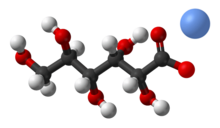
Back قلوکونات سودیوم AZB Natriumgluconat German Natria glukonato Esperanto Gluconato de sodio Spanish گلوکونات سدیم Persian Gluconate de sodium French Nátrium-glükonát Hungarian Նատրիումի գլյուկոնատ Armenian グルコン酸ナトリウム Japanese Natriumgluconaat Dutch
This article needs additional citations for verification. (February 2024) |
 | |
 | |
| Names | |
|---|---|
| IUPAC name
Sodium (2R,3S,4R,5R)-2,3,4,5,6-pentahydroxyhexanoate
| |
| Other names
Sodium D-gluconate
| |
| Identifiers | |
3D model (JSmol)
|
|
| ChEBI | |
| ChEMBL | |
| ChemSpider | |
| ECHA InfoCard | 100.007.644 |
| E number | E576 (acidity regulators, ...) |
PubChem CID
|
|
| UNII | |
CompTox Dashboard (EPA)
|
|
| |
| |
| Properties | |
| C6H11NaO7 | |
| Molar mass | 218.137 g·mol−1 |
| Appearance | White powder |
| Odor | Odorless |
| 58 g/100 mL | |
| Solubility in ethanol and diethyl ether | Slightly soluble |
| Hazards | |
| Lethal dose or concentration (LD, LC): | |
LD50 (median dose)
|
10380 mg/kg (oral, rat)[1] |
Except where otherwise noted, data are given for materials in their standard state (at 25 °C [77 °F], 100 kPa).
| |
Sodium gluconate is a compound with formula NaC6H11O7.[2] It is the sodium salt of gluconic acid. Its E number is E576. This white, water-soluble powder has a wide range of applications across industries. Originally derived from gluconic acid in the 19th century, Sodium Gluconate is known for its chelating properties and is utilized as a chelating agent in various processes. It finds applications in textile, metal surface treatment, cement, and more. Moreover, its non-toxic nature and biodegradability contribute to its use in environmentally conscious practices.
- ^ Chemistry id sis.nlm.nih.gov [dead link]
- ^ "Sodium Gluconate (Chelating Agent): Cosmetic Ingredient INCI". cosmetics.specialchem.com. Retrieved 18 November 2023.